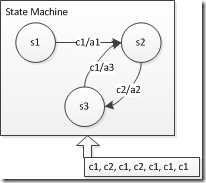

状态机要实现哪些内容
描述
状态机模式是一种行为模式,通过多态实现不同状态的调转行为的确是一种很好的方法,只可惜在嵌入式环境下,有时只能写纯C代码,并且还需要考虑代码的重入和多任务请求跳转等情形,因此实现起来着实需要一番考虑。
近日在看到了一个状态机的实现,也学着写了一个,与大家分享。
首先,分析一下一个普通的状态机究竟要实现哪些内容。
状态机存储从开始时刻到现在的变化,并根据当前输入,决定下一个状态。这意味着,状态机要存储状态、获得输入(我们把它叫做跳转条件)、做出响应。

如上图所示,{s1, s2, s3}均为状态,箭头c1/a1表示在s1状态、输入为c1时,跳转到s2,并进行a1操作。
最下方为一组输入,状态机应做出如下反应:

当某个状态遇到不能识别的输入时,就默认进入陷阱状态,在陷阱状态中,不论遇到怎样的输入都不能跳出。
为了表达上面这个自动机,我们定义它们的状态和输入类型:
typedef int State;
typedef int Condition;
#define STATES 3 + 1
#define STATE_1 0
#define STATE_2 1
#define STATE_3 2
#define STATE_TRAP 3
#define CONDITIONS 2
#define CONDITION_1 0
#define CONDITION_2 1
在嵌入式环境中,由于存储空间比较小,因此把它们全部定义成宏。此外,为了降低执行时间的不确定性,我们使用O(1)的跳转表来模拟状态的跳转。
首先定义跳转类型:
typedef void (*ActionType)(State state, Condition condition);
typedef struct
{
State next;
ActionType action;
} Trasition, * pTrasition;
然后按照上图中的跳转关系,把三个跳转加一个陷阱跳转先定义出来:
// (s1, c1, s2, a1)
Trasition t1 = {
STATE_2,
action_1
};
// (s2, c2, s3, a2)
Trasition t2 = {
STATE_3,
action_2
};
// (s3, c1, s2, a3)
Trasition t3 = {
STATE_2,
action_3
};
// (s, c, trap, a1)
Trasition tt = {
STATE_TRAP,
action_trap
};
其中的动作,由用户自己完成,在这里仅定义一条输出语句。
void action_1(State state, Condition condition)
{
printf("Action 1 triggered.\\n");
}
最后定义跳转表:
pTrasition transition_table[STATES][CONDITIONS] = {
/* c1, c2*/
/* s1 */&t1, &tt,
/* s2 */&tt, &t2,
/* s3 */&t3, &tt,
/* st */&tt, &tt,
};
即可表达上文中的跳转关系。
最后定义状态机,如果不考虑多任务请求,那么状态机仅需要存储当前状态便行了。例如:
typedef struct
{
State current;
} StateMachine, * pStateMachine;
State step(pStateMachine machine, Condition condition)
{
pTrasition t = transition_table[machine- >current][condition];
(*(t- >action))(machine- >current, condition);
machine- >current = t- >next;
return machine- >current;
}
但是考虑到当一个跳转正在进行的时候,同时又有其他任务请求跳转,则会出现数据不一致的问题。
举个例子:task1(s1, c1/a1 –> s2)和task2(s2, c2/a2 –> s3)先后执行,是可以顺利到达s3状态的,但若操作a1运行的时候,执行权限被task2抢占,则task2此时看到的当前状态还是s1,s1遇到c2就进入陷阱状态,而不会到达s3了,也就是说,状态的跳转发生了不确定,这是不能容忍的。
因此要重新设计状态机,增加一个“事务中”条件和一个用于存储输入的条件队列。修改后的代码如下:
#define E_OK 0
#define E_NO_DATA 1
#define E_OVERFLOW 2
typedef struct
{
Condition queue[QMAX];
int head;
int tail;
bool overflow;
} ConditionQueue, * pConditionQueue;
int push(ConditionQueue * queue, Condition c)
{
unsigned int flags;
Irq_Save(flags);
if ((queue- >head == queue- >tail + 1) || ((queue- >head == 0) && (queue- >tail == 0)))
{
queue- >overflow = true;
Irq_Restore(flags);
return E_OVERFLOW;
}
else
{
queue- >queue[queue- >tail] = c;
queue- >tail = (queue- >tail + 1) % QMAX;
Irq_Restore(flags);
}
return E_OK;
}
int poll(ConditionQueue * queue, Condition * c)
{
unsigned int flags;
Irq_Save(flags);
if (queue- >head == queue- >tail)
{
Irq_Restore(flags);
return E_NO_DATA;
}
else
{
*c = queue- >queue[queue- >head];
queue- >overflow = false;
queue- >head = (queue- >head + 1) % QMAX;
Irq_Restore(flags);
}
return E_OK;
}
typedef struct
{
State current;
bool inTransaction;
ConditionQueue queue;
} StateMachine, * pStateMachine;
static State __step(pStateMachine machine, Condition condition)
{
State current = machine - > current;
pTrasition t = transition_table[current][condition];
(*(t- >action))(current, condition);
current = t- >next;
machine- >current = current;
return current;
}
State step(pStateMachine machine, Condition condition)
{
Condition next_condition;
int status;
State current;
if (machine- >inTransaction)
{
push(&(machine- >queue), condition);
return STATE_INTRANSACTION;
}
else
{
machine- >inTransaction = true;
current = __step(machine, condition);
status = poll(&(machine- >queue), &next_condition);
while(status == E_OK)
{
__step(machine, next_condition);
status = poll(&(machine- >queue), &next_condition);
}
machine- >inTransaction = false;
return current;
}
}
void initialize(pStateMachine machine, State s)
{
machine- >current = s;
machine- >inTransaction = false;
machine- >queue.head = 0;
machine- >queue.tail = 0;
machine- >queue.overflow = false;
}
